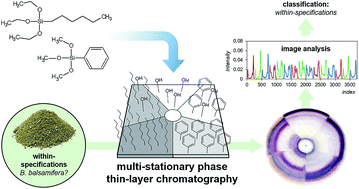Radial multi-stationary phase thin-layer chromatography for the field-ready fingerprinting of herbal materials†
Abstract
The growing international demand for herbal-based products has prompted the need for more stringent quality control methods to detect substandard and adulterated herbal plant materials. However, most prescreening methods, such as thin-layer chromatography (TLC), remain inaccessible to herbal producers in resource-limited settings. Here, we report a proof-of-concept demonstration of a multi-stationary phase thin-layer chromatography (MSP-TLC) method for the preliminary on-site identification and evaluation of herbal materials. Our method is based on a unique TLC plate design that features multiple phenyl- and octyl-modified silica gel stationary phases configured as radial sectors. The modified stationary phase patterns were fabricated by screen-printing organosilane solutions onto commercial silica gel TLC plates. Radial elution with an ethanol–water mobile phase from the center of the MSP-TLC plate generates multiple chromatographic profiles simultaneously for a single sample extract. To facilitate the interpretation of the multiple TLC profiles, the MSP-TLC system was coupled with image analysis and chemometric pattern recognition to classify a sample as “within-specifications” or “off-specifications” for a given herbal plant species. Application of the system to Blumea balsamifera and Vitex negundo demonstrated sensitivity and specificity rates that range from 73.1 to 95.1% compared to the respective standard Pharmacopeia TLC methods. The presented method holds considerable promise as a cost-effective, user-friendly on-site prescreening tool for herbal materials in resource-limited settings.



 Please wait while we load your content...
Please wait while we load your content...